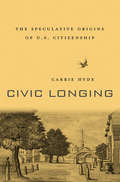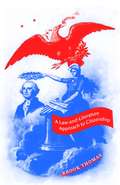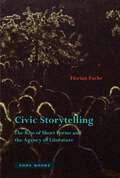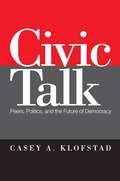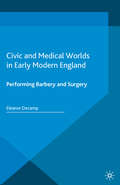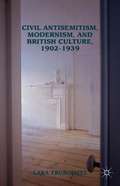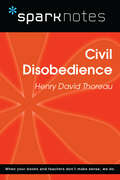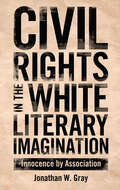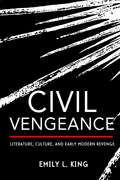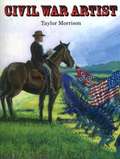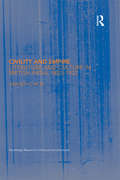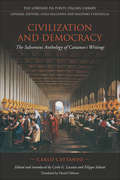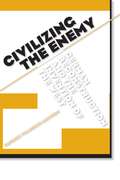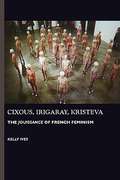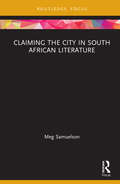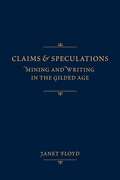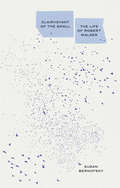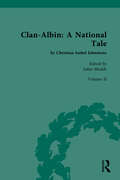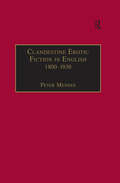- Table View
- List View
Civic Longing: The Speculative Origins of U.S. Citizenship
by Carrie HydeNo Constitutional definition of citizenship existed until the 14th Amendment in 1868. Carrie Hyde looks at the period between the Revolution and the Civil War when the cultural and juridical meaning of citizenship was still up for grabs. She recovers numerous speculative traditions that made and remade citizenship’s meaning in this early period.
Civic Myths
by Brook ThomasAs questions of citizenship generate new debates for this generation of Americans, Brook Thomas argues for revitalizing the role of literature in civic education. Thomas defines civic myths as compelling stories about national origin, membership, and values that are generated by conflicts within the concept of citizenship itself. Selected works of literature, he claims, work on these myths by challenging their terms at the same time that they work with them by relying on the power of narrative to produce compelling new stories.Civic Myths consists of four case studies: Nathaniel Hawthorne's The Scarlet Letter and "the good citizen"; Edward Everett Hale's "The Man without a Country" and "the patriotic citizen"; Mark Twain's Adventures of Huckleberry Finn and "the independent citizen"; and Maxine Hong Kingston's China Men and "the immigrant citizen." Thomas also provides analysis of the civic mythology surrounding Abraham Lincoln and the case of Ex parte Milligan. Engaging current debates about civil society, civil liberties, civil rights, and immigration, Thomas draws on the complexities of law and literature to probe the complexities of U.S. citizenship.
Civic Storytelling: The Rise of Short Forms and the Agency of Literature
by Florian FuchsA deep history of storytelling as a civic agency, recalibrating literature’s political role for the twenty-first centuryWhy did short narrative forms like the novella, fable, and fairy tale suddenly emerge around 1800 as genres symptomatic of literature’s role in life and society? In order to explain their rapid ascent to such importance, Florian Fuchs identifies an essential role of literature, a role traditionally performed within classical civic discourse of storytelling, by looking at new or updated forms of this civic practice in modernity. Fuchs's focus in this groundbreaking book is on the fate of topical speech, on what is exchanged between participants in argument or conversation as opposed to rhetorical speech, which emanates from and ensures political authority. He shows how after the decline of the Ars topica in the eighteenth century, various forms of literary speech took up the role of topical speech that Aristotle had originally identified. Thus, his book outlines a genealogy of various literary short forms—from fable, fairy tale, and novella to twenty-first century video storytelling—that attempted on both "high" and "low" levels of culture to exercise again the social function of topical speech. Some of the specific texts analyzed include the novellas of Theodor Storm and the novella-like lettre de cachet, proverbial fictions of Gustave Flaubert and Gottfried Keller, the fairy tale as rediscovered by Vladimir Propp and Walter Benjamin, the epiphanies of James Joyce, and the video narratives of Hito Steyerl.
Civic Talk: Peers, Politics, and the Future of Democracy
by Klofstad Casey A.Does talking about civic issues encourage civic participation? In his innovative book, Civic Talk, Casey Klofstad shows that our discussions about politics and current events with our friends, colleagues, and relatives—"civic talk"—has the ability to turn thought into action—from voting to volunteering in civic organizations. Klofstad’s path breaking research is the first to find evidence of a causal relationship between the casual chatting and civic participation. He employs survey information and focus groups consisting of randomly assigned college freshman roommates to show this behavior in action. Klofstad also illustrates how civic talk varies under different circumstances and how the effects can last years into the future. Based on these findings, Klofstad contends that social context plays a central role in maintaining the strength of democracy. This conclusion cuts against the grain of previous research, which primarily focuses on individual-level determinants of civic participation, and negates social-level explanations.
Civic and Medical Worlds in Early Modern England: Performing Barbery and Surgery (Early Modern Literature in History)
by E. DecampThrough its rich foray into popular literary culture and medical history, this book investigates representations of regular and irregular medical practice in early modern England. Focusing on the prolific figures of the barber, surgeon and barber-surgeon, the author explores what it meant to the early modern population for a group of practitioners to be associated with both the trade guilds and an emerging professional medical world. The book uncovers the differences and cross-pollinations between barbers and surgeons' practices which play out across the literature: we learn not only about their cultural, civic, medical and occupational histories but also about how we should interpret patterns in language, name choice, performance, materiality, acoustics and semiology in the period. The investigations prompt new readings of Shakespeare, Jonson, Middleton and Beaumont, among others. And with chapters delving into early modern representations of medical instruments, hairiness, bloodletting procedures, waxy or infected ears, wart removals and skeletons, readers will find much of the contribution of this book is in its detail, which brings its subject to life.
Civil Antisemitism, Modernism, and British Culture, 1902–1939
by Lara TrubowitzThis book addresses the development of 'civil' anti-Semitism in twentieth-century Britain, a crucial and often critically neglected strand of anti-Jewish rhetoric that, prior to 1934, was essential to the legitimization of proto-fascist political and literary discourses, as well as stylistic practices within literary modernism.
Civil Disobedience (SparkNotes Philosophy Guide)
by SparkNotesCivil Disobedience (SparkNotes Philosophy Guide) Making the reading experience fun! SparkNotes Philosophy Guides are one-stop guides to the great works of philosophy–masterpieces that stand at the foundations of Western thought. Inside each Philosophy Guide you&’ll find insightful overviews of great philosophical works of the Western world.
Civil Rights Heroes (Great Minds Wit & Wisdom #Grade 2 Module 3)
by Great MindsNIMAC-sourced textbook
Civil Rights Heroes: Assessment Pack (Great Minds Wit & Wisdom #Grade 2, Module 3)
by Great MindsNIMAC-sourced textbook
Civil Rights in the White Literary Imagination: Innocence by Association
by Jonathan W. GrayThe statement, “The Civil Rights Movement changed America,” though true, has become something of a cliché. Civil Rights in the White Literary Imagination seeks to determine how, exactly, the Civil Rights Movement changed the literary possibilities of four iconic American writers: Robert Penn Warren, Norman Mailer, Eudora Welty, and William Styron. Each of these writers published significant works prior to the Brown v. Board of Education case in 1954 and the Montgomery Bus Boycott that began in December of the following year, making it possible to trace their evolution in reaction to these events. The work these writers crafted in response to the upheaval of the day, from Warren's Who Speaks for the Negro?, to Mailer's “The White Negro” to Welty's “Where Is the Voice Coming From?” to Styron's Confessions of Nat Turner, reveal much about their own feeling in the moment even as they contribute to the national conversation that centered on race and democracy. By examining these works closely, Gray posits the argument that these writers significantly shaped discourse on civil rights as the movement was occurring but did so in ways that—intentionally or not—often relied upon a notion of the relative innocence of the South with regard to racial affairs, and on a construct of African Americans as politically and/or culturally naive. As these writers grappled with race and the myth of southern nobility, their work developed in ways that were simultaneously sympathetic of, and condescending to, black intellectual thought occurring at the same time.
Civil Vengeance: Literature, Culture, and Early Modern Revenge
by Emily L. KingWhat is revenge, and what purpose does it serve? On the early modern English stage, depictions of violence and carnage—the duel between Hamlet and Laertes that leaves nearly everyone dead or the ghastly meal of human remains served at the end of Titus Andronicus—emphasize arresting acts of revenge that upset the social order. Yet the subsequent critical focus on a narrow selection of often bloody "revenge plays" has overshadowed subtler and less spectacular modes of vengeance present in early modern culture.In Civil Vengeance, Emily L. King offers a new way of understanding early modern revenge in relation to civility and community. Rather than relegating vengeance to the social periphery, she uncovers how facets of society—church, law, and education—relied on the dynamic of retribution to augment their power such that revenge emerges as an extension of civility. To revise the lineage of revenge literature in early modern England, King rereads familiar revenge tragedies (including Marston's Antonio's Revenge and Kyd's The Spanish Tragedy) alongside a new archive that includes conduct manuals, legal and political documents, and sermons. Shifting attention from episodic revenge to quotidian forms, Civil Vengeance provides new insights into the manner by which retaliation informs identity formation, interpersonal relationships, and the construction of the social body.
Civil War Artist
by Taylor MorrisonWilliam Forbes arrives in New York in 1861, eager to start a career as an artist. When he has difficulty finding work, he signs on with Burton's Illustrated News to sketch the battles of the Civil War. This historical account shows how the news was reported, from William's sketches of dangerous battle scenes through the making of a wood engraving and finally to the printed page of the newspapers of the day.
Civil War Writing: New Perspectives on Iconic Texts (Conflicting Worlds: New Dimensions of the American Civil War)
by William C. Davis Gary W. Gallagher Stephen Cushman Keith Bohannon Sarah Gardner Matthew Gallman Kathryn Shively Brenda Stevenson Elizabeth Varon T. Michael ParrishCivil War Writing is a collection of new essays that focus on the most significant writing about the American Civil War by participants who lived through it, whether as civilians or combatants, southerners or northerners, women or men, blacks or whites. Collectively, as contributors show, these writings have sustained their influence over generations and include histories, memoirs, journals, novels, and one literary falsehood posing as an autobiographical narrative. Several of the works, such as William Tecumseh Sherman’s memoirs or Mary Chesnut’s diary, are familiar to scholars, but other accounts, including Charlotte Forten’s diary and Loreta Velasquez’s memoir, offer new material to even the most omnivorous Civil War reader. In all cases, a deeper look at these writings reveals why they continue to resonate with audiences more than 150 years after the end of the conflict. As supporting evidence for historical and biographical narratives and as deliberately designed communications, the writings discussed in this collection demonstrate considerable value. Whether exploring the differences among drafts and editions, listening closely to fluctuations in tone or voice, or tracing responses in private correspondence or published reviews, the essayists examine how authors wrote to different audiences and out of different motives, creating a complex literary record that offers rich potential for continuing evaluation of the country’s greatest national trauma. Overall, the essays in Civil War Writing underscore how participants employed various literary forms to record, describe, and explain aspects and episodes of a conflict that assumed proportions none of them imagined possible at the outset.
Civility and Empire: Literature and Culture in British India, 1821-1921 (Routledge Research in Postcolonial Literatures #Vol. 7)
by Anindyo RoyThis book addresses the idea of 'civility' as a manifestation of the fluidity and ambivalence of imperial power as reflected in British colonial literature and culture. Discussions of Anglo-Indian romances of 1880-1900, E.M. Forster's The Life to Come and Leonard Woolf's writings show how the appeal to civility had a significant effect on the constitution of colonial subject-hood and reveals 'civility' as an ideal trope for the ambivalence of imperial power itself.
Civilization and Democracy
by Filippo Sabetti Carlo Cattaneo Carlo LacaitaNineteenth-century Italy is a vast, unexplored territory in the history of modern political thought and liberal democratic theory. Apart from Mazzini, Pareto, and Mosca, the authors of this period are little read, even though their central concerns - the riddle of human liberation, progress, and liberty - are as important today as ever. This volume presents a selection of the writings of Carlo Cattaneo (1801-1869), one of the period's most important thinkers, as selected by an equally important personage of a subsequent time, the anti-Fascist intellectual Gaetano Salvemini.Cattaneo had a profound sense of the historical contingencies underlying the quest both to understand human affairs and to realize a self-governing society. Cattaneo's ideas and framework of analysis - like those of John Stuart Mill and Alexis de Tocqueville - were not shaped by a narrow intra-academic agenda but by the great social, economic, and political transformations of his time. The issues he addressed included problems of revolution, reform, and change in the passage to modernity, which extended far beyond the confines of nineteenth-century Italy.The selection of original pieces presented in this translation is preceded by an introduction by the editors, Carlo G. Lacaita and Filippo Sabetti, which guides the reader through Cattaneo's thinking and puts it in a comparative context. Ultimately, however, it is the editors' goal to let this profound Italian thinker speak for himself.
Civilizing the Enemy: German Reconstruction and the Invention of the West
by Patrick Thaddeus JacksonFor the past century, politicians have claimed that "Western Civilization" epitomizes democratic values and international stability. But who is a member of "Western Civilization"? Germany, for example, was a sworn enemy of the United States and much of Western Europe in the first part of the twentieth century, but emerged as a staunch Western ally after World War II. By examining German reconstruction under the Marshall Plan, author Patrick Jackson shows how the rhetorical invention of a West that included Germany was critical to the emergence of the postwar world order. Civilizing the Enemyconvincingly describes how concepts are strategically shaped and given weight in modern international relations, by expertly dissecting the history of "the West" and demonstrating its puzzling persistence in the face of contradictory realities. "By revisiting the early Cold War by means of some carefully conducted intellectual history, Patrick Jackson expertly dissects the post-1945 meanings of "the West" for Europe's emergent political imaginary. West German reconstruction, the foundation of NATO, and the idealizing of 'Western civilization' all appear in fascinating new light. " --Geoff Eley, University of Michigan "Western civilization is not given but politically made. In this theoretically sophisticated and politically nuanced book, Patrick Jackson argues that Germany's reintegration into a Western community of nations was greatly facilitated by civilizational discourse. It established a compelling political logic that guided the victorious Allies in their occupation policy. This book is very topical as it engages critically very different, and less successful, contemporary theoretical constructions and political deployments of civilizational discourse. " --Peter J. Katzenstein, Cornell University "What sets Patrick Jackson's book apart is his attention, on the one hand, to philosophical issues behind the kinds of theoretical claims he makes and, on the other hand, to the methodological implications that follow from those claims. Few scholars are willing and able to do both, and even fewer are as successful as he is in carrying it off. Patrick Jackson is a systematic thinker in a field where theory is all the rage but systematic thinking is in short supply. " --Nicholas Onuf, Florida International University Patrick Thaddeus Jacksonis Assistant Professor of International Relations in American University's School of International Service.
Cixous, Irigaray, Kristeva: The Jouissance of French Feminism
by Kelly IvesJulia Kristeva, Hélène Cixous and Luce Irigaray are among the provocative, and subtle voices in contemporary culture. Here, Kelly Ives discusses their major ideas and their relation to other feminists and to figures such as Marx, Lacan and Freud.
Claiming Breath
by Diane Glancy"This is a rich, satisfying book, full of wisdom."-Choice. "Glancy is a major voice in Native America today. Claiming Breath is a refreshingly honest depiction of contemporary life and an important step in American Indian literature. Non-Indian readers can learn much from Glancy's text, which presents an Indian worldview complete in its holistic complexity and integrity."-American Indian Culture and Research Journal. "An important addition to the literature of white-Indian cultural interrelationships."-World Literature Today. Like poets of legend, Diane Glancy has spent much of her life on the road. For years she supported her family by driving throughout Oklahoma and Arkansas teaching poetry in the schools. Claiming Breath is an account of one of those years, what Glancy calls "a winter count of sorts, a calendar, a diary of personal matters . . . and a final acceptance of the broken past. . . . It's a year that covers more than a year." Diane Glancy teaches creative writing and Native American literature at Macalester College in St. Paul, Minnesota. Her collections of poetry, Iron Woman, and of short fiction, Trigger Dance, have also won major prizes.
Claiming the City in South African Literature
by Meg SamuelsonThis book demonstrates the insights that literature brings to transdisciplinary urban studies, and particularly to the study of cities of the South. Starting from the claim staked by mining capital in the late nineteenth century and its production of extractive and segregated cities, it surveys over a century of writing in search of counterclaims through which the literature reimagines the city as a place of assembly and attachment. Focusing on how the South African city has been designed to funnel gold into the global economy and to service an enclaved minority, the study looks to the literary city to advance a contrary emphasis on community, conviviality and care. An accessible and informative introduction to literature of the South African city at significant historical junctures, this book will also be of great interest to scholars and students in urban studies and Global South studies.
Claims and Speculations: Mining and Writing in the Gilded Age
by Janet FloydMines have always been hard and dangerous places. They have also been as dependent upon imaginative writing as upon the extraction of precious materials. This study of a broad range of responses to gold and silver mining in the late nineteenth century sets the literary writings of figures such as Mark Twain, Mary Hallock Foote, Bret Harte, and Jack London within the context of writing and representation produced by people involved in the industry: miners and journalists, as well as writers of folklore and song.Floyd begins by considering some of the grand narratives the industry has generated. She goes on to discuss particular places and the distinctive work they generated—the short fictions of the California Gold Rush, the Sagebrush journalism of Nevada&’s Comstock Lode, Leadville romance, and the popular culture of the Klondike.With excursions to Canada, South Africa, and Australia, Floyd looks at how the experience of a destructive and chaotic industry produced a global literature.
Clairvoyant of the Small: The Life of Robert Walser
by Susan BernofskyThe first English-language biography of one of the great literary talents of the twentieth century, written by his award-winning translator"Masterful. . . . This balanced and meticulous account shines a bright light on a misunderstood and influential writer.."--Publishers Weekly, Starred Review The great Swiss-German modernist author Robert Walser lived eccentrically on the fringes of society, shocking his Berlin friends by enrolling in butler school and later developing an urban-nomad lifestyle in the Swiss capital, Bern, before checking himself into a psychiatric clinic. A connoisseur of power differentials, his pronounced interest in everything inconspicuous and modest—social outcasts and artists as well as the impoverished, marginalized, and forgotten—prompted W. G. Sebald to dub him &“a clairvoyant of the small.&” His revolutionary use of short prose forms won him the admiration of Franz Kafka, Walter Benjamin, Robert Musil, and many others. He was long believed an outsider by conviction, but Susan Bernofsky presents a more nuanced view in this immaculately researched and beautifully written biography. Setting Walser in the context of early twentieth century European history, she provides illuminating analysis of his extraordinary life and work, bearing witness to his &“extreme artistic delight.&”
Clan-Albin: by Christian Isobel Johnstone (Chawton House Library: Women's Novels)
by Juliet ShieldsChristian Isobel Johnstone’s Clan-Albin: A National Tale was published in 1815, less than a year after Walter Scott’s Waverley; or ‘tis Sixty Years Since enthralled readers and initiated a craze for Scottish novels. Both as a novelist and as editor of Tait’s Edinburgh Magazine from 1834 to 1846, Johnstone was a powerful figure in Romantic Edinburgh’s literary scene. But her works and her reputation have long been overshadowed by Scott’s. In Clan-Albin, Johnstone engages with themes on British imperial expansion, metropolitan England’s economic and political relationships with the Celtic peripheries, and the role of women in public life. This rare novel, alongside extensive editorial commentary, will be of much interest to students of British Literature.
Clan-Albin: by Christian Isobel Johnstone (Chawton House Library: Women's Novels)
by Juliet ShieldsChristian Isobel Johnstone’s Clan-Albin: A National Tale was published in 1815, less than a year after Walter Scott’s Waverley; or ‘tis Sixty Years Since enthralled readers and initiated a craze for Scottish novels. Both as a novelist and as editor of Tait’s Edinburgh Magazine from 1834 to 1846, Johnstone was a powerful figure in Romantic Edinburgh’s literary scene. But her works and her reputation have long been overshadowed by Scott’s. In Clan-Albin, Johnstone engages with themes on British imperial expansion, metropolitan England’s economic and political relationships with the Celtic peripheries, and the role of women in public life. This rare novel, alongside extensive editorial commentary, will be of much interest to students of British Literature.
Clandestine Erotic Fiction in English 1800–1930: A Bibliographical Study
by Peter MendesThis work offers bibliographical descriptions of all printings of erotic fiction in English issued clandestinely during the period 1800-1930. By 'clandestine' is meant books whose publishers and printers attempt to hide their identities, usually by offering title pages whose misleading places and dates of publication may shock and amuse, but which always aim to mystify. Using internal and external evidence, an attempt is made to establish who were the printers, booksellers and publishers, English and Continental, involved in this trade. The printing families or 'groups' into which a large percentage of the material falls are classified, accompanied by illustrations which identify the main printing characteristics ('house styles') of the groups. Bibliographical descriptions follow a checklist of clandestine catalogues; these provide valuable evidence for dating, pricing and 'sales pitch' and information on items of which no copies can now be traced. The work concludes with a series of appendices which provide significant external evidence, and three indexes: of themes, titles and names. Peter Mendes' original research builds on and significantly extends the essential pioneer work of the Victorian collector and bibliographer H.S. Ashbee ('Pisanus Fraxi').
Clandestine Marriage: Botany and Romantic Culture
by Theresa M. KelleyBotany in the romantic era played a role in debates about life, nature, and knowledge, as evidenced in this ambitious, beautifully illustrated study.Winner, 2012 British Society for Literature and Science Book PrizeRomanticism was a cultural and intellectual movement characterized by discovery, revolution, and the poetic as well as by the philosophical relationship between people and nature. Botany sits at the intersection where romantic scientific and literary discourses meet. Clandestine Marriage explores the meaning and methods of how plants were represented and reproduced in scientific, literary, artistic, and material cultures of the period. Theresa M. Kelley synthesizes romantic debates about taxonomy and morphology, the contemporary interest in books and magazines devoted to plant study and images, and writings by such authors as Mary Wollstonecraft and Anna Letitia Barbauld. Period botanical paintings of flowers are reproduced in vibrant color, bringing her argument and the romantics' passion for plants to life.In addition to exploring botanic thought and practice in the context of British romanticism, Kelley also looks to the German philosophical traditions of Kant, Hegel, and Goethe and to Charles Darwin’s reflections on orchids and plant pollination. Her interdisciplinary approach allows a deeper understanding of a time when exploration of the natural world was a culture-wide enchantment.
